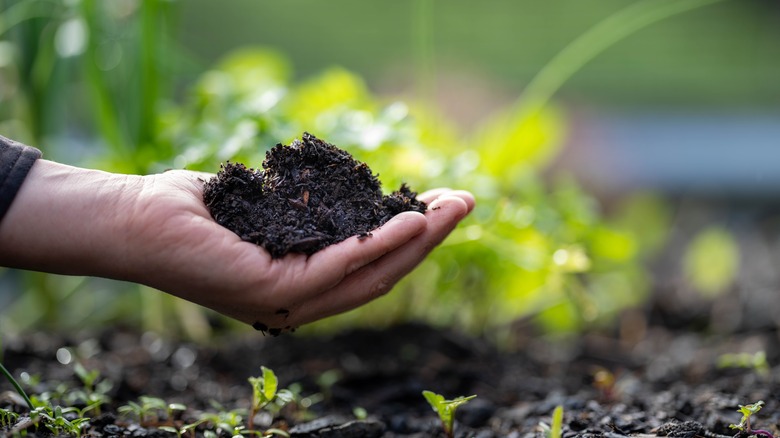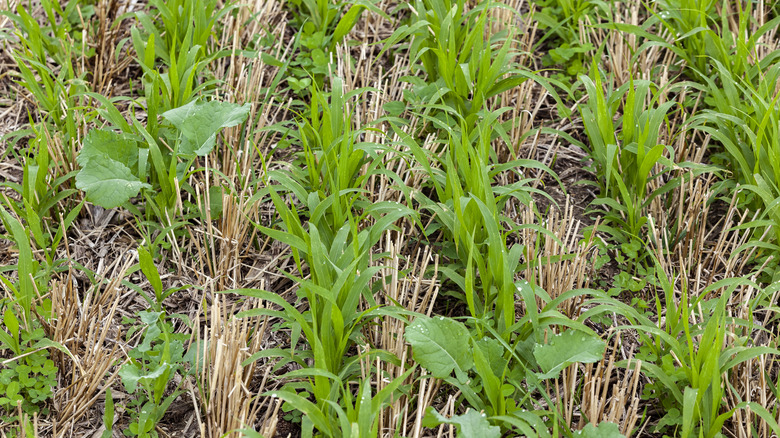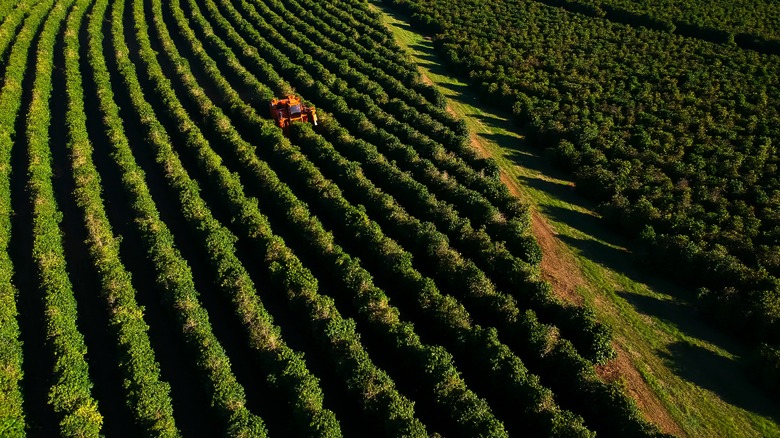How Regenerative Farming Could Impact The Food We Buy In Years To Come
No matter how tuned in or out of farming standards you might be, chances are you are aware that some foods are deemed "healthier" because of how they were raised. One example of this is organic farming, which includes everything from produce to coffee to wine. But what if there was another type of farming, an alternative to traditional and organic farming, that promised even more? This is where regenerative farming comes into play.
Traditional farming practices have long relied on pesticides, synthetic fertilizers, and monoculture cropping to maximize yields, often at the expense of soil health and biodiversity. In contrast, regenerative farming is a sustainable agricultural approach that seeks to restore and enhance the land's natural ecosystems. It focuses on practices like crop rotation, cover cropping, and minimal tillage to improve soil health, sequester carbon, and reduce the need for chemical inputs. This shift to regenerative farming is poised to revolutionize our food and drink supply in the future.
Firstly, it promises healthier and more nutrient-rich crops, as regenerative practices nurture soil microorganisms, which in turn promote plant health. Secondly, it addresses climate change by capturing and storing carbon in the soil, mitigating greenhouse gas emissions. Thirdly, it boosts resilience against pests and diseases through diversified ecosystems, reducing the reliance on chemical pesticides. Ultimately, regenerative farming not only ensures sustainable agriculture but also offers a path towards a more ecologically balanced and food-secure future. Let's delve into just how these farming practices can promise so much.
What is regenerative farming?
Regenerative farming differs from organic farming in several ways. While both aim to reduce chemical inputs and promote ecological sustainability, organic farming primarily focuses on what is not allowed — synthetic chemicals, genetically modified organisms (GMOs), and irradiation — whereas regenerative farming focuses on actively improving soil health, sequestering carbon, and enhancing ecosystem services. Organic certification standards may vary by region, while regenerative farming focuses on outcomes rather than rigid rules, allowing for flexibility and adaptation to local conditions.
Regenerative farming is a holistic and sustainable approach to agriculture that prioritizes the restoration and rejuvenation of ecosystems while producing food. Common practices in regenerative farming include cover cropping, that is growing other plants to prevent erosion and water loss, and the integration of livestock and other animals into farming systems. These methods promote soil health, enhance biodiversity, and reduce the need for synthetic inputs like pesticides and fertilizers. One key feature of regenerative farming is the rating system used to assess its sustainability and effectiveness.
Farms can receive ratings such as AA or AAA based on their adherence to regenerative principles and their demonstrated positive impact on the environment. These rankings help consumers identify and support farms that are committed to sustainable practices. In essence, regenerative farming represents a paradigm shift in agriculture, moving away from practices that harm the environment and towards methods that heal and restore it. It's a forward-looking approach that not only sustains food production but also ensures the long-term health of our planet.
What is the impact of regenerative farming?
The impact of regenerative farming is nothing short of transformative, and it matters profoundly for our planet's future. At its core, regenerative farming is about more than just growing food; it's about regenerating our environment. By adopting positive practices, regenerative farming not only helps combat climate change but also revitalizes ecosystems. With these practices, farms can become more resilient to climate change. One of the most significant impacts of regenerative farming is its positive effect on the environment.
It reduces soil erosion, enhances water quality, and promotes wildlife habitat. Moreover, regenerative practices have the potential to make agriculture carbon-neutral or even carbon-negative. This means that, rather than contributing to greenhouse gas emissions, these farms actively remove carbon dioxide from the atmosphere through carbon sequestration in healthy soils. Crucially, the knowledge and best practices of regenerative farming are being widely shared across the industry. Farmers, scientists, and organizations like the Rainforest Alliance are collaborating to disseminate information and provide training, fostering a community of regenerative practitioners.
Some companies are going above and beyond to support this knowledge-sharing which not only accelerates the adoption of regenerative methods but also ensures that these practices can be tailored to diverse agricultural landscapes. According to Julie Dubost, Nespresso Global Brand PR Senior Manager, more than 75% of Nespresso coffee is bought from such farms and supports their regenerative research which is open-sourced for other coffee farms around the world. General Mills is also focused on sourcing from regenerative farms.
The future of food with regenerative farming
The future of food with regenerative farming is promising and transformative. Regenerative practices are changing the landscape of agriculture, and their impact extends to food and beverages — including the source crops for the likes of coffee and wine — in profound ways. The quality and taste of food products are being elevated to new heights as regenerative farming nurtures healthier soils and more vibrant ecosystems.
While some might expect that such high-quality products would come at a premium price, regenerative farming is also demonstrating cost-effectiveness by reducing the need for costly synthetic inputs and excessive water and promoting long-term sustainability. Consumers can learn more about the importance of soil health and our food systems by watching the 2020 documentary, "Kiss the Ground" and its 2023 sequel, "Common Ground." Looking ahead, the projections for regenerative farming are promising. As awareness of its benefits grows, more farmers are likely to adopt regenerative practices, leading to an increase in regenerative agriculture's share of global food production.
This shift could have far-reaching consequences, from mitigating climate change through carbon sequestration to bolstering food security and preserving biodiversity. In the future, we can expect to see regenerative farming as a mainstream practice, not just a niche movement. As it continues to reshape our food systems, the impact on the quality, taste, and sustainability of our favorite foods and beverages will only become more pronounced, ensuring a brighter, more sustainable, and tastier future for all.



